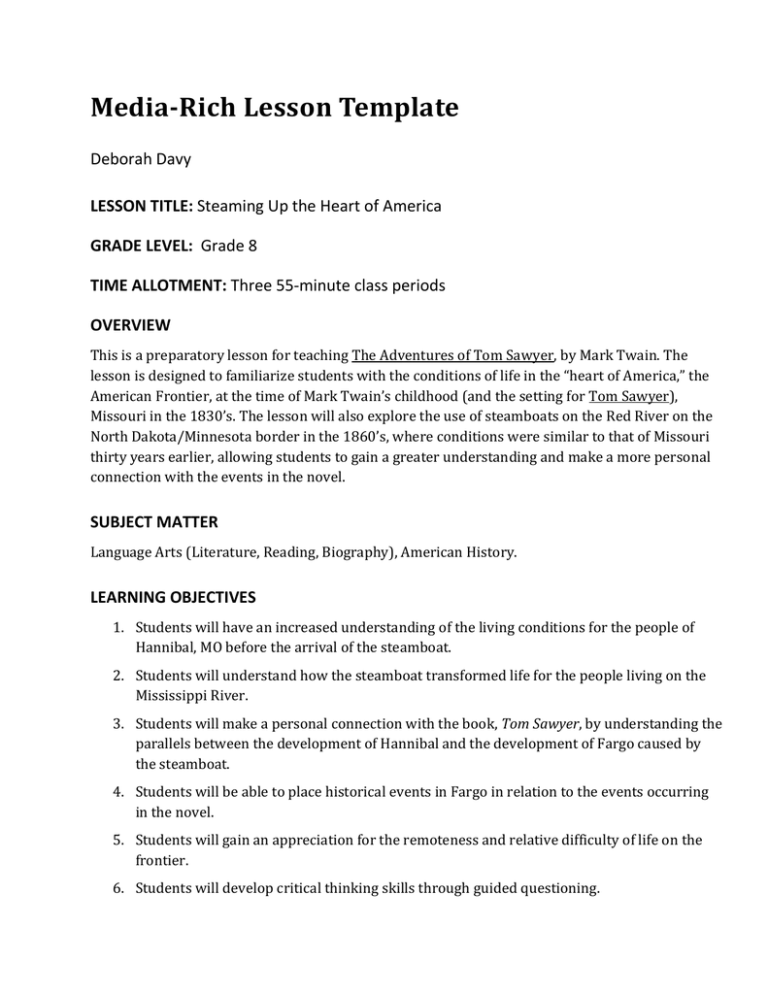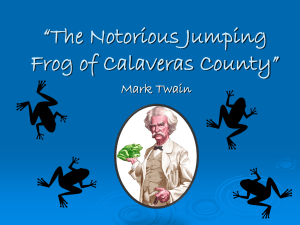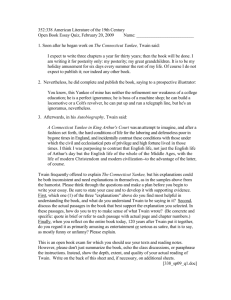Steaming Up the Heart of America Lesson Plan
advertisement

Media-Rich Lesson Template Deborah Davy LESSON TITLE: Steaming Up the Heart of America GRADE LEVEL: Grade 8 TIME ALLOTMENT: Three 55-minute class periods OVERVIEW This is a preparatory lesson for teaching The Adventures of Tom Sawyer, by Mark Twain. The lesson is designed to familiarize students with the conditions of life in the “heart of America,” the American Frontier, at the time of Mark Twain’s childhood (and the setting for Tom Sawyer), Missouri in the 1830’s. The lesson will also explore the use of steamboats on the Red River on the North Dakota/Minnesota border in the 1860’s, where conditions were similar to that of Missouri thirty years earlier, allowing students to gain a greater understanding and make a more personal connection with the events in the novel. SUBJECT MATTER Language Arts (Literature, Reading, Biography), American History. LEARNING OBJECTIVES 1. Students will have an increased understanding of the living conditions for the people of Hannibal, MO before the arrival of the steamboat. 2. Students will understand how the steamboat transformed life for the people living on the Mississippi River. 3. Students will make a personal connection with the book, Tom Sawyer, by understanding the parallels between the development of Hannibal and the development of Fargo caused by the steamboat. 4. Students will be able to place historical events in Fargo in relation to the events occurring in the novel. 5. Students will gain an appreciation for the remoteness and relative difficulty of life on the frontier. 6. Students will develop critical thinking skills through guided questioning. STANDARDS RI.8.3. Analyze how a text makes connections among and distinctions between individuals, ideas, or events (e.g., through comparisons, analogies, or categories). RL.8.3. Analyze how particular lines of dialogue or incidents in a story or drama propel the action, reveal aspects of a character, or provoke a decision. RI.8.6. Determine an author’s point of view or purpose in a text and analyze how the author acknowledges and responds to conflicting evidence or viewpoints. SL.8.2. Analyze the purpose of information presented in diverse media and formats (e.g., visually, quantitatively, orally) and evaluate the motives (e.g., social, commercial, political) behind its presentation. MEDIA COMPONENTS 1. Mark Twain: His Amazing Adventure. Biography, Cat. No. AAE-71062 http://www.learn360.com/ShowVideo.aspx?ID=226946&SearchText=Mark+Twain++His+Am azing+Adventure 2. Steamboats on the Red; a Story of Buccaneers and Robber Barons. Prairie Public Productions, 2011. 3. PowerPoint presentation,“Mark Twain’s America”. MATERIALS Quote and questions sheet (provided). One copy each of two videos (listed above) OR link to website for the first video. PowerPoint presentation on “Mark Twain’s America”. PREP FOR TEACHERS Before class: Have the DVD’s and handouts ready. Open the PowerPoint presentation on your computer. Project or write the Twain quote at the top of the board. Leave room to draw a timeline later. Have this showing when class begins. Queue up the Mark Twain biography DVD to the beginning of the film. INTRODUCTORY ACTIVITY: SETTING THE STAGE (Day 1) 1. Introduce the following quote by Mark Twain, then ask students to respond to it. Some possible discussion questions are provided separately (below). “When I was a boy, there was but one permanent ambition among my comrades in our village on the west bank of the Mississippi River. That was, to be a steamboatman. We had transient ambitions of other sorts, but they were only transient. When a circus came and went, it left us all burning to become clowns; the first negro minstrel show that came to our section left us all suffering to try that kind of life; now and then we had a hope that if we lived and were good, God would permit us to be pirates. These ambitions faded out, each in its turn; but the ambition to be a steamboatman always remained.” - Mark Twain, from Life on the Mississippi 2. Ask students to imagine life in the middle of the continent in the 1830’s. How might Mark Twain have spent his free time? What activities do kids today have available to them? (Eg. video games, bikes, football, board games, listening to music, etc.) Write these activities on the board, leaving room for the timeline. LEARNING ACTIVITIES (Day 1) 3. Draw a timeline from 1830 to 2012 across the entire board. Mark the time in decades. Ask students to guess when each activity or technology from their list was invented or established. Then give them the correct dates and mark them on the timeline. Reinforce how few of these were available to Twain in the 1830’s. 4. Show the PowerPoint presentation, “Mark Twain’s America” and discuss the main events and conditions of the time period. Reinforce the appeal of the steamboat to a boy living on the Mississippi River at that time. 5. Hand out the “Notes on Mark Twain Video” sheets. Direct students’ attention to the focus questions on their sheets. 6. Show the first 15 minutes of the Twain video. Keep the lights on during viewing. 7. Stop the video a few minutes before the end of class to allow students to record answers to any questions on these scenes that they may have missed. 8. Make sure to note the place in the film where you stopped. LEARNING ACTIVITIES (Day 2) Preparation: Queue up the Mark Twain biography DVD to the place where you ended the day before. Keep the lights on. 1. Make sure students have their Notes sheets ready. Direct students’ attention to the focus questions on their sheets. 2. Show the rest of the Twain film. 3. Facilitate a student discussion of the film, making sure to reinforce Twain’s love of steamboats and piloting them. 4. Go over the answers to the questions on the students’ Notes sheet. LEARNING ACTIVITIES (Day 3) Preparation: Queue up the “Steamboats on the Red River” DVD to the first scene. Keep the lights on. 1. Introduce the topic of steamboats on the Red River. Ask what students know about the history of Fargo and steamboats. 2. Hand out the “Notes on Steamboats” question sheets. 3. Show the video, “Steamboats on the Red”. 4. Facilitate a student discussion of the film. Suggested questions are provided separately (below). CULMINATING ACTIVITY 1 This activity is done after the above lesson. Students write a reflection about what does and does not appeal to them about how they imagine life in the 1830’s. Allow time for students to share their thoughts in pairs or as a group. CULMINATING ACTIVITY 2 This activity is done after students have completed reading The Adventures of Tom Sawyer. Students write a reflection in which they compare Tom Sawyer’s childhood to their own. Some possibilities to consider: In what ways might life in the 1830’s have been better than growing up today? How might it have been worse? What would you miss most about the things you have and are able to do today? Consider the relative safety and convenience of modern life compared to life on the American frontier in the 1830’s. How well do you think you would deal with the hardships? How much freedom and independence does Tom have compared to you? How do you feel about the differences? What are your thoughts about the way children were treated by adults (parents, teachers, community members) in the novel? Compare that with today, and give your opinion. CROSS-CURRICULAR EXTENSIONS This lesson has the potential to work as a cross-curricular unit with Social Studies/American History if the Social Studies curriculum at the school includes the same time period as the novel (1830’s). As this is not the case in my school, no cross-curricular activities have been developed. COMMUNITY CONNECTIONS A field trip to view historical exhibitions at the Hjemcomst Center museum in Moorhead, MN, that depict early settler life in the Red River Valley could provide reinforcement and elaboration of the lesson. STUDENT MATERIALS Pencil “Notes on Mark Twain Video” handout. “Notes on Steamboats on the Red” handout. Notebook for recording ideas, writing reflections. See next pages for additional materials. Mark Twain Quote “When I was a boy, there was but one permanent ambition among my comrades in our village on the west bank of the Mississippi River. That was, to be a steamboatman. We had transient ambitions of other sorts, but they were only transient. When a circus came and went, it left us all burning to become clowns; the first negro minstrel show that came to our section left us all suffering to try that kind of life; now and then we had a hope that if we lived and were good, God would permit us to be pirates. These ambitions faded out, each in its turn; but the ambition to be a steamboatman always remained.” - Mark Twain, from Life on the Mississippi Discussion Questions for Quote What do you know about steamboats? What might be appealing about being a steamboat pilot? What other “careers” does Twain mention? Why do you suppose he chooses these? What other exciting careers would have been available to a boy living in a small town on the Mississippi in the 1830’s? How would Mark Twain have spent his free time as a boy? Discussion Questions for “Steamboats on the Red” How long does it take you to travel to Minneapolis today? (by car/by plane) Compare this to how long it took early settlers to travel by oxcart. It took Northrup months to bring only part of his steamboat from Crow Wing to Moorhead (155 miles). How long would it take a truck to bring freight on this route today? Why would it not be possible to create a monopoly today? Compare and contrast the Red River and the Mississippi River. How important is the Red River to the cities of Fargo and Moorhead today? Timeline Before 1830 Marbles, dolls, wooden toys, chess, checkers, jacks, hoop and stick, games like Tag, Blind Man’s Bluff, dress up and role-playing, etc. 1845 First club baseball game. 1860’s Roller skates become popular. 1869 First college football game in U.S. 1877 Thomas Edison invents the phonograph. 1879 Thomas Edison demonstrates his electric light bulb. 1880’s Bicycles become popular. Early (silent) film technology invented. 1889 Flexible Flyer sled. 1891 Basketball game invented. 1903 Crayons invented. 1909 Professional hockey established. 1913 Electric refrigerator invented. Professional soccer established. 1920’s Movies become popular. 1920 Professional football established in U.S. 1926 Miniature golf invented. 1930’s Electric power becomes more available. The Rural Electrification Act is passed. “Talkies” (film with sound) and color films developed. 1933 Monopoly invented. 1940 Early television developed. 1957 Frisbee invented. 1960’s Color television developed. 1970’s Early business computers developed. 1972 Pong – first arcade video game. 1975 Skateboard invented. 1976 First VCR introduced. 1979 Sony Walkman introduced. 1983 First home computers. Early cell phones. First Nintendo video game system and “SuperMario” (in Japan; introduced to U.S. in 1985) Late 1980’s – 1990’s Internet developed. 1993 First text message. 1997 MP3 player introduced. 2001 Ipod introduced. How Mark Twain Would Have Played Before the Industrial Revolution, toys and games for children were few and simple. Dolls, tops, stick horses, and hoops & sticks are some examples. Children would also dress up and act out what they wanted to be one day. This often included famous figures from books they were familiar with, like Robin Hood or King Arthur. During Mark Twain’s childhood, the most popular activity for boys was collecting and playing a variety of games with marbles. He would also have spent a lot of time exploring the natural environment around Hannibal, swimming, hunting and fishing. No organized sports for children existed, even in schools, in the area. NOTES ON MARK TWAIN VIDEO Name ________________________________ Per. _____ 1. Name three different jobs that Samuel Clemens held in his lifetime. 2. Name three states in which Samuel Clemens lived. 3. Name any works of Mark Twain’s other than The Adventures of Tom Sawyer. 4. What war influenced Samuel Clemens’ life? 5. Where did Samuel Clemens grow up? (city/state) 6. On what river did Samuel Clemens grow up? What was Samuel Clemens’ dream? 7. How old was Samuel Clemens when he had to get his first job? Why was this necessary? 8. What was his trademark? 9. What was the book The Adventures of Tom Sawyer based on? 10. What were two pen names Samuel Clemens used before Mark Twain? over 11. What was the origin of his pen name Mark Twain? 12. What are the “Sandwich Islands” now called? 13. Michael Jordan wasn’t the first celebrity to endorse products! Name two of Mark Twain’s endorsements? 14. Explain Mark Twain’s connection with U. S. Grant. 15. What was Mark Twain’s “masterpiece,” a story with a twelve-year-old boy and an escaped slave as the main characters? 16. What two deaths contributed to Mark Twain’s increasing loneliness and bitterness? 17. In what did he invest that contributed to his financial downfall? 18. What did he do at the age of sixty to earn money? 19. What honor did Mark Twain receive in 1907? Who were the special guests? 20. How did Mark Twain embarrass his family? NOTES ON STEAMBOATS VIDEO Name ________________________________ Per. _____ 1. What made the trip from London to Winnipeg via Minnesota twice as fast as the route through Hudson's Bay? 2. Why did St. Paul businessmen want steamboats to be brought to the Red River? 3. How long did it take Northrup to bring part of a steamboat from Crow Wing to the Red River? 4. Why did the Chippewa sometimes object to steamboats traveling through their lands along the Red River? 5. Why is water the cheapest, fastest way of moving people and goods? 6. Why did Northrup choose to build a new boat hull instead of taking oxcarts back along his trail to pick up the entire boat? 7. What is a monopoly, and how did the Hudson Bay Company create a monopoly of the fur trade in this area? 8. What advantage does a monopoly give a company? 9. What ended the steamboat industry on the Red River?



